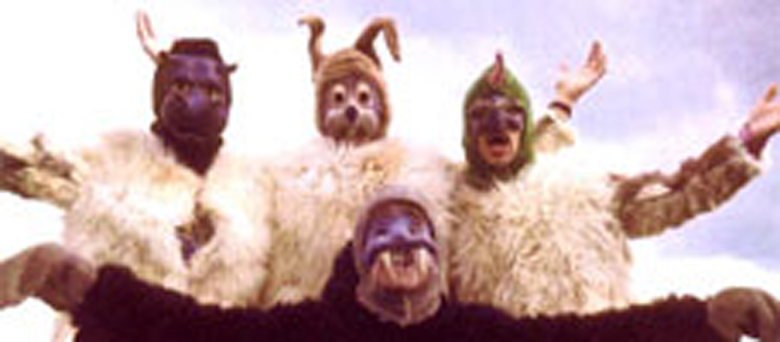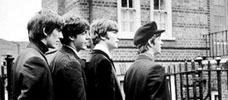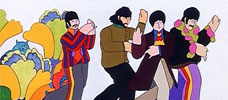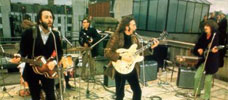Reviews
The Beatles
UK, 1967
Credits
Review by Megan Weireter
Posted on 07 September 2009
Source Apple VHS
Categories The Beatles on Film
With two films for United Artists under their belts, the Beatles and director Richard Lester amicably parted ways, while Walter Shenson, who’d produced the first two movies, tried to find a script suitable for the band’s contractually obligated third film. That script was never found, though, leaving the UA contract in a kind of limbo until 1970’s Let It Be. Meanwhile, in between the summers of 1965 (when Help! was released) and 1967, the Beatles wrapped up their touring careers and began to intensely focus on developing their music in the studio, an effort which culminated in the release of Sgt. Pepper’s Lonely Hearts Club Band in June of 1967. The album was heralded as one of the greatest masterpieces of pop music, and the Beatles clearly felt more than ever before that they could do no wrong.
You can sense that feeling of untouchability running through Magical Mystery Tour, the film project that they began working on after the Sgt. Pepper album. A brainstorm of Paul McCartney’s, the film served as a welcome distraction from the turmoil that followed the untimely death of their manager, Brian Epstein — and it was also, significantly, the first film project that the Beatles really took on more or less alone. Influenced by both the psychedelic surrealism then in vogue and by their own egotistical belief that whatever they touched would turn to gold, Magical Mystery Tour is a curiosity in the Beatles’ career — and their first flop, which seems to have stunned them. Though the hour-long movie, which first aired on BBC TV on Boxing Day of 1967 (admittedly not its ideal market), has seen a resurgence in critical support in the years since its release, it still feels too much like an experiment and too little like a finished film to be as engaging as what has come before.
The whole concept of Magical Mystery Tour is, depending on how you feel about such things, either an homage to surrealism or just hopelessly naíve. The plan was for the band to hire a bus, fill it with themselves and a gang of friends as well as a few professional actors, drive it around, and film what happened. Each Beatle contributed ideas for premises that made their way into a shooting script of sorts, but the dialogue was all pretty much improvised. (For instance, John had a dream in which a waiter shoveled mounds of spaghetti onto his plate, which he thought was funny enough to propose filming — weirdly, it’s one of the better scenes.) Paul later described their process as similar to that of making an album, in that everyone contributed a scene in the same way that they would contribute a song.
But by 1967, the Beatles took much more care in the way they wrote their songs and created their albums than they did with this movie, which was finished filming in a matter of days and hastily edited. In Magical Mystery Tour, the Beatles were entirely in charge of a movie for the first time, and had they applied the perfectionism and work ethic that informed their music, it might have turned out better. Perhaps they were beginning to believe their own mythology — and why not, after so many years of unprecedented success? Or perhaps their hearts just weren’t in it. At any rate, the result is a series of very silly scenes whose ability to entertain you largely depends on whether or not you’re a big Beatles fan to begin with. Help! was also a series of silly scenes, of course, with not much more plot to hold it together than Magical Mystery Tour has — but in Help!, the Beatles worked under a director who was quite skilled at capturing comic anarchy. Here, without anyone providing that kind of direction, they flounder.
Thus, threads are introduced and then awkwardly dropped, seemingly just out of disorganization. The mysterious (and mentally ill) Buster Bloodvessel announces that he’s fallen in love with Ringo’s Aunt Jessie, but it’s unclear whether it’s reciprocated. It’s also unclear which of them is having their lovey-dovey dream sequence, in which they walk on a beach and moon at each other like kids. Later, the men and women separate — the men go to a strip club, which we get to see, but we never discover where the women have gone. And it’s hard to say why the bus would visit an army recruiting office at all, other than to give the Beatles’ friend Victor Spinetti (who had stolen scenes in their previous two films) a chance to play a blowhard sergeant with difficulties annunciating — certainly the most overt “performance” in the film.
The Beatles’ first film established them in the public imagination as hilarious and talented but also resolutely normal, while their second film pushed their normalcy to its outer limits by playing up their wit, eccentricity, and unwitting heroism. In Magical Mystery Tour the Beatles become more unreal, or perhaps surreal, as characters, even as they continue to play with our conceptions of them as normal working-class lads. This is their only film in which the Beatles play characters other than themselves: they are the magicians, exerting control over the entire bus ride and making sure that magic and “a lovely time” befall all on board. This is, indeed, how the Beatles were beginning to be seen in popular culture — as leaders of the free love generation. Timothy Leary famously heralded them as “the wisest, holiest, most effective avatars the human race has ever produced,” but he wasn’t the only one who was beginning to hear Beatles music less as something to dance to and more as a kind of mystical call. Paul goes a step further to add to Beatle mythos (or his own mythos) in the video for “The Fool on the Hill,” in which he plays the Fool, staring off into space and dancing wildly. The Fool has dropped out of the society that never understood him to begin with, and Paul seems to be encouraging the kids to do the same. The anarchy that always lay beneath the surface of their comedies is thus made explicit in Magical Mystery Tour.
But they’re not just magicians and fools: the Beatles also play themselves on the bus, sitting among all the other normal people on the trip. Ringo even brings along his totally square Aunt Jessie, whom he bickers with on and off the entire ride in improvised dialogue that would be at home in any domestic comedy. And the Beatles are some of the most enthusiastic participants in the mundane activities enjoyed by the riders — laughing maniacally at the winking comic stylings of Jolly Jimmy, the courier; singing their hearts out to old songs like “Toot-Toot-Tootsie Goodbye” and “When Irish Eyes Are Smiling”; nudging themselves with wicked smirks as they watch the stripper in the penultimate scene; blowing up a balloon for a little girl on the bus to play with. They fit in just fine with everyone on the bus, whether it’s the more unusual characters — the midget with the camera, the starlet who seems to not know why she’s there - or all the other completely normal English travelers. The whole concept of a “mystery tour” is a wholly working-class English construct, after all. (These were real trips popular in the middle of the century. Ticket-holders boarded a bus and were taken to a surprise location, usually the seaside or the countryside, in a pleasant and economical package.) And it represents, in a way, the entire straight culture that Paul’s “Fool on the Hill” encourages us to reject. Thus the Beatles don’t quite come across as revolutionaries. They’d rather inject some magic into the world than destroy the world and start over. (We won’t see them literally “drop out” until the next film, Yellow Submarine—the one that the Beatles themselves had nothing to do with making.)
Speaking of the songs, Magical Mystery Tour unfortunately suffers by comparison here as well. In their previous two movies, the Beatles had dazzled viewers with new songs that surpassed anything that had come before. Not so in this movie. (To be fair, after Sgt. Pepper this might have been an unrealistic expectation.) “The Fool on the Hill” is beloved by many, but it takes itself too seriously for my tastes. “Your Mother Should Know” is shallow, “Flying” is boring, and “Blue Jay Way” isn’t bad but is almost too heavy and dreary for this film (though it’s got a pretty good video to go along with it). The standout, of course, is “I Am the Walrus,” probably one of John Lennon’s best songs ever. The delirious randomness of the lyrics and the disorienting psychedelic instrumentation seem right at home in the world of Magical Mystery Tour. If anything, “I Am the Walrus” is the most terrifying element in a film where nothing bad ever really happens. The video for this song is the only part of the film in which the Beatles are actually performing as a band, actually playing their instruments in something like a normal way. Maybe that’s why it seems so bizarre when they put on the animal costumes and play the song that way. There’s a lot of darkness and a lot of fun in the “I Am the Walrus” video, almost in a Lewis Carroll sort of way. (Carroll was John’s favorite author.) It’s not only the best song in the film, it’s the best scene in the film.
And though this wouldn’t have been intentional, “I Am the Walrus” makes a statement about Beatle identity as well. Who are the Beatles? Is John a walrus? The song’s placement in Magical Mystery Tour comes across as John’s attempt to explode the question of identity, period, but particularly of his identity as a Beatle, and the others’ besides. “I Am the Walrus” turns the issue into nonsense. But of course there’s no avoiding the question, ultimately. The movie ends with a Busby Berkeley�influenced musical number in which the Beatles dance to “Your Mother Should Know” in shimmering white suits. Who are they now? They’re not magicians anymore, but they don’t seem to be those laughing guys on the bus either. If they are our psychedelic gurus, they’re also making a very conscious appeal to older audiences and their notion of “family entertainment” with this nod to old Hollywood. What the scene ultimately does is continue to play up the Beatles’ otherness, whatever that is exactly. Magical Mystery Tour, the film that the Beatles exerted complete artistic control over, ends up building their mythology to greater heights than ever, and not even the film’s critical failure could do anything to change that.
More The Beatles on Film
We don’t do comments anymore, but you may contact us here or find us on Twitter or Facebook.








